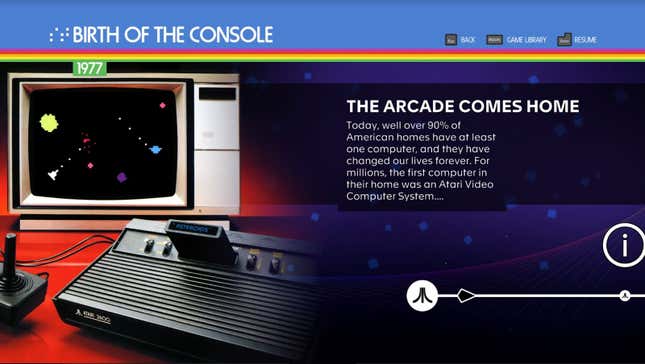This Atari Retrospective Sets A New Standard For Game Anthologies (original) (raw)
Yesterday in a Twitter thread, the gaming historian Frank Cifaldi said this about the work done by his organization, the Video Game History Foundation: “We all know where the ROMs are hiding online. We don’t need games, we need CONTEXT to tell stories.” It helped me realize why I think Digital Eclipse’s new compilation of Atari games, Atari 50, is so essential. Filled not just with games but with timelines charting the history of Atari’s world-changing forays into gaming and, best of all, interviews with some of the people who shaped that history, Atari 50 provides the context we need in order to understand just how significant and innovative these games are.
Suggested Reading
This Mini Sega Arcade Cabinet Packed With Retro Games Would Make A Great Gift
- Off
- English
Suggested Reading
To provide just one example of how Atari 50 helps put things in perspective, here’s a brief clip in which Tim Schafer, the designer of games like Grim Fandango and Psychonauts, talks about what made the landmark 1980 Atari title Adventure so great_._
This tendency toward contextualizing Atari’s games extends throughout the compilation. If you want to just jump right to a list of the playable included games, you can do that. (It’s a curated list, not a comprehensive one, which includes many essentials but is missing others, some—like the fascinating Atari 2600 game _Superman_—no doubt for licensing reasons.) But the default mode in which Atari 50 presents its collection of games to you is via an interactive historical timeline where you can read about Atari’s ups and downs, the challenges its programmers faced working on the Atari 2600 hardware, and so much more, all while playing the games that each era of Atari produced.

Screenshot: Digital Eclipse / Atari
It’s so wonderful, and part of what makes it wonderful are its candid and revealing interviews and historical details. There’s always a danger with something like this that what you’ll get is clean, shiny PR masquerading as history, something that tries to present everything as neat and tidy. But this is no airbrushed commercial for the Atari brand. As you work your way through the timeline, you encounter stories of clueless CEOs misunderstanding the nature of the business, of workers being severely underpaid for their amazing and immensely profitable creations (and sometimes breaking off to form third-party developers like Activision and Imagic), and of drug use in the hallowed halls of Atari’s Sunnyvale headquarters.
I’m old enough to remember the Atari 2600’s heyday, and one thing that’s been a bit sad for me in more recent decades is seeing many people be either ignorant or dismissive of Atari’s contributions to game history. I know that in some ways Atari 2600 games can be hard to go back to if you’ve grown up with games that are far more technologically sophisticated, but the work designers did on Atari’s console and arcade games was colossal. I still think many of these games are genuinely great. Warlords is one of the most thrilling pick-up-and-play competitive multiplayer games of all time, and _Star Raiders_—the Atari 5200’s “killer app”—is utterly extraordinary at creating a sense of traveling through vast sectors of space to take on an alien threat. But what we need to preserve the magnitude of these contributions to game history isn’t just the ROMs themselves, which, yes, are everywhere, easily accessible by anyone who wants to seek them out. It’s the voices of the people who were there, and an informed perspective on the magnitude of their achievements within the context of the time in which they occurred.
One of the struggles of video game historians is that the industry is dominated by corporations, and corporations don’t really care about preserving their history, they only care about making money. Atari 50 is so refreshing because it feels like the people behind it cared about offering an honest perspective on this history while also celebrating the achievements of these brilliant designers and innovators. (Howard Scott Warshaw, the genius behind Yars’ Revenge, Atari’s best-selling original game for the 2600, is a particularly lively and spirited interview in the collection.) I’d love nothing more than for other companies to start following suit, offering us anthologies that are much more than anthologies—that are interactive history.
Imagine if Nintendo put out a compilation filled not just with early Famicom and NES games, but with archival video footage, as well as frank interviews with famed game designer Shigeru Miyamoto and other figures who were there, that together offered a rich, complex perspective on that era of Nintendo history. In all likelihood, such a thing will never happen because Nintendo is far too protective of its brand to put out something that isn’t just a glossy commercial for itself, but one can dream. In the meantime, Atari 50 offers both an important look at video games’ past, and an exciting look at what the future of video game anthologies could be.